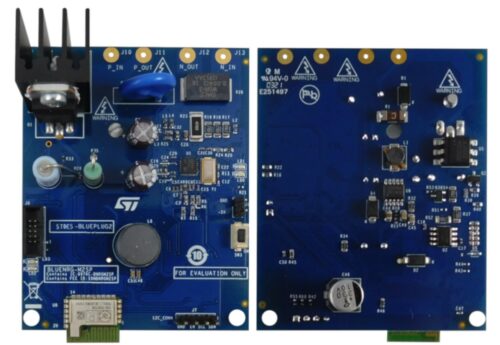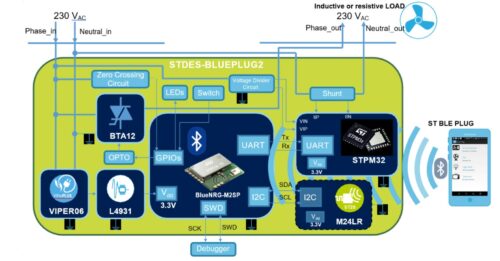A smart plug that is enabled for IoT and based on a Bluetooth low energy (BLE) system-on-chip (SoC) application processor module.

In the progressive world, the Internet of Things (IoT) has the potential to revolutionize the way we live and work in many ways, making our lives more convenient, efficient, and safer. For example, IoT can be used to monitor and optimize energy consumption, manage traffic flow, and reduce waste. Turning on or off any electronic device with your smart device is no new thing when it comes to IoT. STMicroelectronics have made the lives of engineers easy by launching a reference design of smart plugs, especially for home automation. The reference design uses Bluetooth Low Energy (BLE) specification 5.2 to facilitate the secure transmission of metering data from designated electrical loads to a BLE-supported smartphone. The device can perform multiple roles concurrently, functioning as both a Bluetooth smart master and slave device simultaneously. The device can connect with the smartphone application or any other smart device, allowing access to load management features such as turning ON/OFF, scheduling, dimming, and metering parameters. This design is optimal in applications that require a small form factor and do not require a large current.
The reference design is based on the BLUENRG-M2SP, a certified BLE SoC application processor module, which complies with BLE specification 5.2. When connected to AC mains, the device’s current consumption ranges from 3 to 7 mA. The device functions as a BLE peripheral device, linking it to any smart device using the specific Android application. This enables users to manage and track the load and its energy metrics. The smart plug contains an STPM32 metering chip that accurately measures power and energy in power line systems that utilize shunt current sensors. It also features a three-terminal triode for alternating current (TRIAC) that regulates the current flow through AC switching for diverse electrical system applications, along with a non-isolated buck converter supply that is based on the VIPER06XS.

The standard metering IC monitors the main supply and loads. In contrast, the Bluetooth Low Energy module manages data and command interfacing with the Android application, which is designed for the board. Additionally, the module can store data through the Electrically Erasable Programmable Read-only Memory (EEPROM) connector. The board comes equipped with a manual switch that enables users to switch the load on and off, as well as LEDs that indicate the connectivity status.
Features of STMicroelectronics Reference Design:
- Smart Energy Meter design with wireless connectivity
- BLE (Bluetooth Low Energy) v5.2 connectivity to control and display metering parameters
- NFC interface: to configure the design and store the logs
- Dimming of light for TRIAC dimmable load rated below 12 A
- Rated voltage: 240/120 VAC
- Rated current: 12 A
- Power consumption of plug: 0.7 W (max.)
- Instantaneous and averaged power
- RMS and instantaneous voltage and current
STMicroelectronics has tested this reference design. It comes with a Bill of Material (BOM), schematics, etc. You can find additional data about the reference design on the company’s website. To read more about this reference design, click here.






